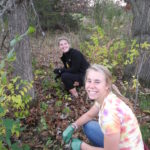
This summer, as you stroll the wooded trails of the Arboretum, be on the lookout for our new public enemy number one. Its name is Amur cork tree (Phellodendron amurense), and there’s a good chance you’ll be hearing more about this tree species in the future.
Hundreds of young saplings of this tree species were discovered and identified in 2016 as part of routine plant surveys in the Arboretum. Upon their discovery in late fall, Gustavus students assisted with eradication efforts to reduce their numbers as much as possible. Most of the plants were just a couple of feet tall with pencil-thick stems and easily pulled by hand. Hand-pulling continued until leaf-drop, at which time the plants became much more difficult to locate.
It was quickly deduced that a mature parent tree must exist in the Arboretum as the seed source. The parent tree was found and quickly felled and removed to prevent further seed production. Ironically, arboretum records show that the parent tree was, indeed, planted in the early years of the Arboretum as an individual specimen tree and has existed for many years largely unnoticed in an out-of-the-way location.
Being a dioecious species (having separate male and female individuals) it may have been unknown at the time of planting whether it was a male plant or a female capable of producing seeds. At some point in the recent past, a male Amur cork tree must have reached maturity in the St. Peter area and began fertilizing our lone female (cue Frank Sinatra’s “Strangers in the Night”). Based on the average age of the saplings, it looks like the mystery male tree must have attained maturity is the past few years.
Shortly after the discovery, employees with the MN DNR Forestry Division as well as the MN Department of Agriculture (MDA) were notified. Subsequent surveys by DNR staff have confirmed pockets of relatively mature Amur cork tree growing in some of the wooded areas in Mankato, confirming the tree’s establishment in the area.
Prior to these discoveries, there appears to have been a general skepticism among natural resource professionals about the ability of Amur cork tree to naturalize this far north. Cork tree is not yet included on the MDA’s noxious plant list, but very well could be added in the near future.
Now that it seems clear that cork tree can survive and spread in southern MN, it is important that homeowners and landowners be able to identify this plant. The good news is that it is quite distinctive and relatively easy to identify.
It is actually a rather attractive tree, with a rounded, broad-spreading crown. The mature bark is very cork-like (hence the name) and the leaves are pinnately compound, vaguely similar in growth form to walnut leaves. One of the most distinctive features is a pungent, skunky odor when green summer leaves are rubbed or crushed. Another distinctive feature is a bright fluorescent yellow coloration of the cambium area when the bark is cut or stripped away. The pea-sized black fruits of mature trees exist as grape-like clusters at the ends of branches. The foliage changes to a dull yellow color in the fall making them relatively easy to spot until the leaves drop.
Following the impromptu hand-pulling management of last fall, the Arboretum has secured a Minnesota DNR cost-share grant to retain woodland management professionals to assist with further eradication efforts in the 2017 growing season. Although there are still likely hundreds of cork tree saplings remaining in the arboretum, it is believed that none of them are mature seed producers. However, there are still many seeds lying dormant in the soil, so long term eradication will require many years of vigilance.
Scott Moeller, Director and Naturalist


